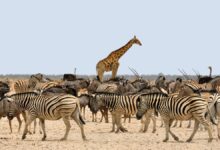Okapis: The Enigmatic Rainforest Dwellers

Okapi: The Enigmatic Rainforest Dweller
Okapi
Introduction
The okapi, often referred to as the “forest giraffe,” is a remarkable and mysterious animal native to the dense rainforests of Central Africa. Despite its zebra-like stripes, the okapi is more closely related to the giraffe. These elusive creatures are seldom seen in the wild due to their remote habitats and cautious nature.
Scientific Overview
Scientific Name
The okapi’s scientific name is Okapia johnstoni, and it was named in honor of the British explorer Sir Harry Johnston, who helped introduce this species to Western science.
Common Name
Known commonly as the okapi, it is sometimes called the “forest giraffe” due to its close genetic ties to giraffes.
Scientific Classification
| Kingdom | Animalia |
| Phylum | Chordata |
| Class | Mammalia |
| Order | Artiodactyla |
| Family | Giraffidae |
| Genus | Okapia |
| Species | Okapia johnstoni |
Types
The okapi is a unique species with no known subspecies, although there are variations in stripe patterns and size among individuals.
Habitat and Distribution
Okapis are exclusively found in the dense rainforests of the Democratic Republic of Congo. They prefer thick vegetation that provides both cover and a rich supply of vegetation for food. The Ituri Forest is a major habitat for these animals, providing them a sanctuary away from human intrusion.
Physical Characteristics
Size and Weight
Okapis typically stand about 5 feet tall at the shoulder and weigh between 440 and 770 pounds. Males are generally smaller than females, who can weigh as much as 880 pounds.
Appearance
The okapi has a distinctive appearance marked by a deep brown, velvety coat with striking white and black stripes on its legs, which serve as camouflage among the trees and shadows. Its body resembles that of a giraffe, with a long neck and large, upright ears, which aid in detecting sounds in its dense habitat. Okapis have a prehensile tongue that is long, flexible, and adept at grasping foliage—much like their giraffe relatives.
Diet and Feeding Habits
The okapi is an herbivore, primarily feeding on leaves, buds, grasses, fruits, and fungi. Their long, agile tongue allows them to reach and strip leaves from branches, even those that are difficult to access. This tongue also helps in grooming. Okapis are known to consume over 100 different plant species, many of which are toxic to humans, which points to their highly specialized diet.
Predators and Threats
Though okapis have few natural predators, leopards are known to prey on them, especially young or weaker individuals. Human activity poses a significant threat to okapis, as deforestation and illegal hunting for bushmeat or skins have led to a decline in their population. Furthermore, the instability and conflict in their native regions complicate conservation efforts.
Reproduction, Babies, and Lifespan
Female okapis give birth to a single calf after a gestation period of about 14 to 15 months. Calves are well-developed at birth and can stand and walk within hours. However, they often remain hidden and nurse for up to six months before venturing out. Okapis in the wild typically have a lifespan of around 15 years, though in captivity, they can live up to 30 years.

Population and Conservation Status
Okapis are listed as Endangered by the International Union for Conservation of Nature (IUCN). Their population is estimated to be between 10,000 and 50,000 individuals, but their numbers are declining due to habitat loss and poaching. Conservation organizations and local governments have established reserves and are working to create more awareness about the okapi’s plight.
Behavior and Lifestyle
Okapis are solitary animals, coming together only for mating purposes. They mark their territory with scent glands located on their feet. Typically, okapis are crepuscular, meaning they are most active during the dawn and dusk hours. Their large, sensitive ears help them detect any approaching predators or potential dangers in the dense forest.
Ecological Role
As browsers, okapis play an important role in the ecosystem by helping to maintain the health of their forest habitats. By consuming various plant species, they aid in controlling vegetation growth, which indirectly benefits other species and maintains biodiversity within their ecosystem.
FAQs About Okapis
- Are okapis related to giraffes?
Yes, okapis and giraffes share a common family, Giraffidae. While they may look quite different, their skeletal structures and other biological characteristics reveal their shared ancestry. - How do okapis protect themselves from predators?
Okapis rely on their striped camouflage and keen senses, particularly hearing, to detect predators. They are also very cautious and tend to avoid open areas, making them hard to spot. - Where can I see an okapi in the wild?
Okapis are native only to the dense rainforests of the Democratic Republic of Congo. Due to their elusive nature and restricted habitat, it is challenging to observe them in the wild. - What do baby okapis look like?
Baby okapis resemble adults but are smaller and lack the pronounced striping pattern. They are usually hidden away for the first few weeks to avoid attracting predators. - Why are okapis endangered?
Okapis face threats from habitat destruction, illegal hunting, and political instability in their native region. Conservation efforts are ongoing to protect their habitats and prevent poaching.
Conclusion
The okapi is a fascinating and rare creature, embodying both the mystery and beauty of the African rainforests. Although much remains unknown about these elusive animals, efforts to protect and study them continue to shed light on their important role in the ecosystem. With ongoing conservation efforts, there is hope that future generations will be able to admire and appreciate the okapi as a symbol of nature’s resilience and diversity.


